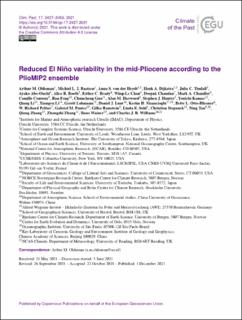Reduced El Niño variability in the mid-Pliocene according to the PlioMIP2 ensemble
| dc.contributor.author | Oldeman, Arthur M. | |
| dc.contributor.author | Baatsen, Michiel L. J. | |
| dc.contributor.author | Von Der Heydt, Anna S. | |
| dc.contributor.author | Dijkstra, Henk A. | |
| dc.contributor.author | Tindall, Julia C. | |
| dc.contributor.author | Abe-Ouchi, Ayako | |
| dc.contributor.author | Booth, Alice R. | |
| dc.contributor.author | Brady, Esther C. | |
| dc.contributor.author | Chan, Wing-Le | |
| dc.contributor.author | Chandan, Deepak | |
| dc.contributor.author | Chandler, Mark A. | |
| dc.contributor.author | Contoux, Camille | |
| dc.contributor.author | Feng, Ran | |
| dc.contributor.author | Guo, Chuncheng | |
| dc.contributor.author | Haywood, Alan M. | |
| dc.contributor.author | Hunter, Stephen J. | |
| dc.contributor.author | Kamae, Youichi | |
| dc.contributor.author | Li, Qiang | |
| dc.contributor.author | Li, Xiangyu | |
| dc.contributor.author | Lohmann, Gerrit | |
| dc.contributor.author | Lunt, Daniel J. | |
| dc.contributor.author | Nisancioglu, Kerim Hestnes | |
| dc.contributor.author | Otto-Bliesner, Bette L. | |
| dc.contributor.author | Peltier, W. Richard | |
| dc.contributor.author | Pontes, Gabriel M. | |
| dc.contributor.author | Ramstein, Gilles | |
| dc.contributor.author | Sohl, Linda E. | |
| dc.contributor.author | Stepanek, Christian | |
| dc.contributor.author | Tan, Ning | |
| dc.contributor.author | Zhang, Qiong | |
| dc.contributor.author | Zhang, Zhongshi | |
| dc.contributor.author | Wainer, Ilana | |
| dc.contributor.author | Williams, Charles J. R. | |
| dc.date.accessioned | 2022-02-16T11:28:03Z | |
| dc.date.available | 2022-02-16T11:28:03Z | |
| dc.date.created | 2022-01-04T17:54:26Z | |
| dc.date.issued | 2021 | |
| dc.identifier.citation | Climate of the Past. 2021, 17 (6), 2427-2450. | en_US |
| dc.identifier.issn | 1814-9324 | |
| dc.identifier.uri | https://hdl.handle.net/11250/2979332 | |
| dc.description.abstract | The mid-Pliocene warm period (3.264–3.025 Ma) is the most recent geological period during which atmospheric CO2 levels were similar to recent historical values (∼400 ppm). Several proxy reconstructions for the mid-Pliocene show highly reduced zonal sea surface temperature (SST) gradients in the tropical Pacific Ocean, indicating an El Niño-like mean state. However, past modelling studies do not show these highly reduced gradients. Efforts to understand mid-Pliocene climate dynamics have led to the Pliocene Model Intercomparison Project (PlioMIP). Results from the first phase (PlioMIP1) showed clear El Niño variability (albeit significantly reduced) and did not show the greatly reduced time-mean zonal SST gradient suggested by some of the proxies. In this work, we study El Niño–Southern Oscillation (ENSO) variability in the PlioMIP2 ensemble, which consists of additional global coupled climate models and updated boundary conditions compared to PlioMIP1. We quantify ENSO amplitude, period, spatial structure and “flavour”, as well as the tropical Pacific annual mean state in mid-Pliocene and pre-industrial simulations. Results show a reduced ENSO amplitude in the model-ensemble mean (−24 %) with respect to the pre-industrial, with 15 out of 17 individual models showing such a reduction. Furthermore, the spectral power of this variability considerably decreases in the 3–4-year band. The spatial structure of the dominant empirical orthogonal function shows no particular change in the patterns of tropical Pacific variability in the model-ensemble mean, compared to the pre-industrial. Although the time-mean zonal SST gradient in the equatorial Pacific decreases for 14 out of 17 models (0.2 ∘C reduction in the ensemble mean), there does not seem to be a correlation with the decrease in ENSO amplitude. The models showing the most “El Niño-like” mean state changes show a similar ENSO amplitude to that in the pre-industrial reference, while models showing more “La Niña-like” mean state changes generally show a large reduction in ENSO variability. The PlioMIP2 results show a reasonable agreement with both time-mean proxies indicating a reduced zonal SST gradient and reconstructions indicating a reduced, or similar, ENSO variability. | en_US |
| dc.language.iso | eng | en_US |
| dc.rights | Navngivelse 4.0 Internasjonal | * |
| dc.rights.uri | http://creativecommons.org/licenses/by/4.0/deed.no | * |
| dc.title | Reduced El Niño variability in the mid-Pliocene according to the PlioMIP2 ensemble | en_US |
| dc.type | Journal article | en_US |
| dc.type | Peer reviewed | en_US |
| dc.rights.holder | © The Authors, 2021 | en_US |
| dc.description.version | publishedVersion | en_US |
| cristin.ispublished | true | |
| cristin.fulltext | original | |
| cristin.qualitycode | 1 | |
| dc.identifier.doi | 10.5194/cp-17-2427-2021 | |
| dc.identifier.cristin | 1974683 | |
| dc.source.journal | Climate of the Past | en_US |
| dc.source.volume | 17 | en_US |
| dc.source.issue | 6 | en_US |
| dc.source.pagenumber | 2427-2450 | en_US |

